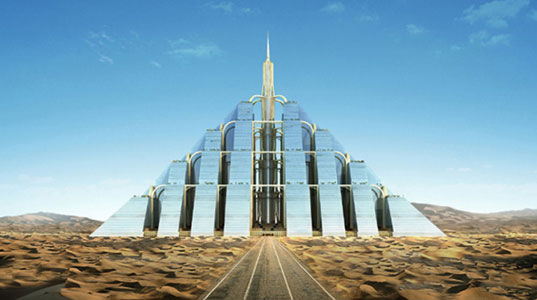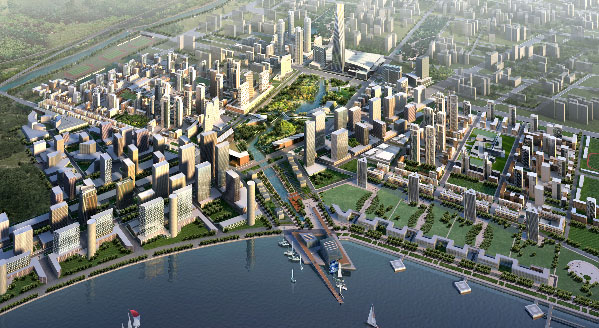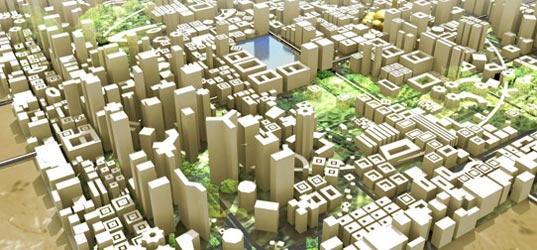Offshoring Audacity
 [Image: Dubai's "carbon-neutral" ziggurat, designed by Timelinks].
[Image: Dubai's "carbon-neutral" ziggurat, designed by Timelinks].I'll be in Chicago next week to host a panel on Saturday, November 8, as part of this year's Chicago Humanities Festival. The other participants are Joseph Grima, Jeffrey Inaba, and Sam Jacob.
More info:
- Look abroad: Whole cities are planned, built, and inhabited in less than a generation. Artificial islands, indoor ski slopes, and the world’s tallest this-and-that are being constructed, not in the West, but in the Middle East, China, and beyond. The result: a sense that the West’s cities are falling behind and, increasingly, watching from the sidelines. A dynamic panel will discuss the accuracy of this assessment of today’s architectural situation. What are the urban implications of so-called offshoring audacity and how can the phenomenon be described without resorting to nationalism, nostalgia, or even uncritical celebration?
The panelists will be Joseph Grima, executive director of New York’s Storefront for Art and Architecture and author of Instant Asia; Jeffrey Inaba, principal architect, Inaba Projects, and professor of architecture at SCI-Arc and Columbia University; and Sam Jacob, visiting professor at Yale University and founding director, Fashion Architecture Taste, a London-based practice. The discussion will be moderated by Geoff Manaugh, author of BLDGBLOG and senior editor of Dwell magazine.
I hope some Chicago-based readers might stop by.
 [Image: Park Gate, Dubai, by Adrian Smith + Gordon Gill Architecture].
[Image: Park Gate, Dubai, by Adrian Smith + Gordon Gill Architecture].The overall theme for the Humanities Festival this year is "big ideas," inspired by architect Daniel Burnham's (possibly apocryphal) statement that one should "make no little plans." Since we're coming up on the 100-year anniversary of Burnham's urban plan for Chicago, not only does a "big ideas" – or "big plans" – Festival seem appropriate, but a panel about cities and urban design even more so.
 [Image: New Songdo City, South Korea].
[Image: New Songdo City, South Korea].The specific goal, then, is to discuss the idea that the West has begun "offshoring audacity" – urban and architectural audacity – to places like Dubai, Shanghai, Abu Dhabi, Beijing, and South Korea.
The United States, in particular, seems to have ceded its role as an architectural and infrastructural innovator. Every week, a new indoor ski resort or artificial island-city or hyperbolic "green" pyramid is announced somewhere, in a non-Western nation – or the Chinese government announces a program of urban weather control – leaving the U.S. a nation of failed levees, foreclosed suburbs, and collapsing bridges.
These examples of 21st-century spatial exotica are our era's new fantasy environments – instant cities rolled out across the desert like magic carpets, with all of their plumbing and services intact.
It is architecture at its most audacious (or so we're told).

 [Image: RAK Gateway, Ras Al Khaimah, United Arab Emirates, by OMA].
[Image: RAK Gateway, Ras Al Khaimah, United Arab Emirates, by OMA].The question becomes: How can we discuss all of this without resorting either to chest-puffing nationalism (it's not true, the West is the best) or to a kind of knee-jerk Spenglerian resignation (it's true, the West is over)?
Put another way: Is there really any purpose in celebrating the newest mile-high tower or solar-powered private golf community, as every architecture blog in the world seems to think we need to do right now – or, conversely, is cynicism in the face of mile-high towers really the most interesting or appropriate response?
 [Image: Contemporary architecture's well-rendered visual overload, parodically assembled by OMA].
[Image: Contemporary architecture's well-rendered visual overload, parodically assembled by OMA].There's an interesting exchange in Joseph Grima's new book Instant Asia: Fast Forward through the Architecture of a Changing Continent. There, Qingyun Ma describes the trajectory of the Chinese architect as one of concentration: You start off huge, designing million-square-foot office complexes – if not whole cities from scratch – before gradually being established and respected enough in your field simply to design a house, say, or a single storefront.
With this in mind, is the steroidal grandeur of today's Chinese architecture simply the visible articulation of a different professional arc? Start fast – start big – then concentrate?
Are these architects building resumés, not cities?
On the other hand, if many of these towers continue to be designed, engineered, and built by western firms, are we actually witnessing a kind of bizarre projection of the West's own subconscious needs onto the blank slates of other nations? I'm reminded here of Marcus Trimble's quip that China, with its replicant Eiffel Towers and fake chateaux, has become a kind of architectural back-up harddrive for the French.
Are developing nations being used as blank spatial slates upon which the West will rewrite its own architectural history?
This also brings to mind Martin Heidegger's under-appreciated comment that American gigantism – Koolhaasian Manhattanism – is simply a grotesque reflection of intellectual tendencies within the trajectory of Europe itself. The U.S., he wrote, was a "concentrated rebound" of European thought, the camouflaged return of its own monstrous offspring.
Is this what we're now witnessing, then, taking architectural form abroad?
Or, conversely, is the presupposed difference here between the West and the Rest so impossible to maintain or to define rigorously that nothing's being "offshored" anywhere – because there's no outside to offshore to?


 [Images: Waterfront City masterplan, Dubai, by OMA. It's worth reading counter-discussions of this project by Nicolai Ouroussoff and Lebbeus Woods, respectively].
[Images: Waterfront City masterplan, Dubai, by OMA. It's worth reading counter-discussions of this project by Nicolai Ouroussoff and Lebbeus Woods, respectively].In the end, then, how are we to judge these claims to architectural monstrosity made by 7-star hotels and indoor ski ranges – buildings that supposedly demonstrate alternative futures, or space on maximum overdrive?
Are these places really that extraordinary – or are they a kind of imaginative cul-de-sac, a sign that architects have resolutely failed to design a more interesting spatial future?
Have we mistaken sheer scale and algorithmic excess for formal bravery?
Has "audacity" in architecture really been "offshored" to other nations, after all – or is audacity something that architecture has lost altogether?
Where should we look to find the truly audacious?
Stop by the panel on November 8 to hear these and other questions discussed: Offshoring Audacity.





Comments are moderated.
If it's not spam, it will appear here shortly!
Offshoring Audacity: How the Hollow Leadership of the West is Spreading Environmental Collapse
That is what this conference should be about. Its all well and good that the architecture dreams in shining towers and green-washed desert oasis, but when actually built, the scale of depravity is appalling.
The West should be looking to contract its audacious over-consumption not see it exported. We have flaunted our ecologically corrupt forms as beacons of pride while our core has rotted.
We need to humble our architecture and find a new path of true sustainability that honors our landbase, or local environments, not the phallic powers of the past industrial era.
Hopefully the West can re-emerge as an awakened leader—repenting its juvenile forms of the last hundred years—and guiding the global community in an effort to reshape the notion of the pinnacle of civilization as fostering the natural rather than raping it for resources.
Audacity is not a virtue.
See yourself in Philly anytime soon?
Derrick - I was there earlier this year for a quick talk at Penn, but there are no definite plans at the moment. I've got a lot of family in the area, though, so a trip is never that unlikely! I'm sure I'll be there in the first half of 2009 or thereabout. Plus I'll be nearby for what I hope will be a big east coast event for the release of the BLDGBLOG Book.
Please tell me thing thing will be recorded and put up somewhere on the web... would really like to see it.
Whoo-hoo! Looks fantastic ... I'll be there, schedule permitting.
My vote is for along the lines of yur closing passage.
"Are these places really that extraordinary – or are they a kind of imaginative cul-de-sac, a sign that architects have resolutely failed to design a more interesting spatial future?
Have we mistaken sheer scale and algorithmic excess for formal bravery?"
What is interesting about the big to small trajectory of young Chinese firms is that in interviews many of them seem to suggests that the small is much more demanding of them (intellectually, architecturally etc) especially when they are first used to big.
'Look abroad: Whole cities are planned, built, and inhabited in less than a generation. Artificial islands, indoor ski slopes, and the world’s tallest this-and-that are being constructed, not in the West, but in the Middle East, China, and beyond. The result: a sense that the West’s cities are falling behind and, increasingly, watching from the sidelines.'
From an aesthetic and architectural point of view, I do not see this as Europe (perhaps more so the States) falling behind. Apart from not having the tallest, shiniest structures of Dubai (though you can bring up the Shard project in London and the Gehry Guggenheim musuem in Spain), it continues to have innovative buildings built and combines it with a historical background, which creates a much richer texture to European urban environments. I agree with SnowflakeSeven about the need to make sure that new architectural projects are more eco-concious.
I think the fact that the emerging Eastern cities are pre-designed leaves a lot of room for hugely positive aspects of urban planning and efficiency, but also provides a good chance of creating sterile and boring landscapes.
my reaction to the question: "What are the urban implications of so-called offshoring audacity and how can the phenomenon be described without resorting to nationalism, nostalgia, or even uncritical celebration?"
The way in which this question is phrased only invites the exact sort of response you seek to exclude. "Off-shoring" implies that the "role of architectural and infrastructural innovator" does in fact only belong to one nation or group of nations. my view is that "there's no outside to offshore to". A very eurocentric view of the world leads to this "othering" of cities like dubai, shanghai, etc and thus gives rise to the sort of responses that really have little useful place in the discussion IMHO. i'm inclined to put the previous comment somewhere in the chest-beating nationalism arena. . .
disorganized responses to the previous comment:
Whether something is sterile or boring or not is partially a matter of taste. And while an abundance of glass and shiny metal may leave strong impressions of a "sterile" hospital environment, I think you can hardly call these landscapes boring. We are after building with the materials of our generation.
Paris was pre-designed. As was Budapest (in the mold of Paris) and a host of other western cities. They reinforce the view that it "leaves a lot of room for hugely positive aspects of urban planning and efficiency" as they were interesting models in their time and even today, but I would as easily call the uniformity of the Parisian or Prague city center boring.
Saying one model is prettier or less boring than the other misses the point. (and ignoring the fact that buildings in these growing cities also combine with a local historical background indicates an only superficial acquaintance with some of the projects around the world). I think the issue is that of increasing (and accelerating) urbanisation in places that to date, did not have to be.
While Europe does have innovative new buildings (I think that point can't be debated), the scale of what we see in newly-urbanizing countries cannot easily be matched. The west is "falling behind", but because its difficult to re-order an entire existing city, update buildings to new environmental or technological standards, etc. when there is so much old building stock.
We are shocked and awed because what happened over time, and seemingly organically (european cities are not as organic as one implies) is happening as greg posts, in a relatively short period of time. It's keeping time with technological advances in a way and on a scale that i find encouraging and awe-inspiring. . . i echo the thought/hope that major advances in environmental engineering as well.
i do think there is a point in not being cynical about the new biggest buildings wherever they crop - while they aren't to my taste, the mere fact that they increasingly incorporating cutting edge architectural and environmental engineering technology is enough reason to dissect and understand the buildings. i'm an advocate of "traditional" architecture, whatever that's supposed to mean, but i also think that these buildings are exciting new science projects allowing us to test and see technology evolve. blah i'm rambling. apologies. interesting topic, but i think comes from a mindset that's already "nationalist, chest-beating".
"
A little more than a century ago, the relationship between people and place underwent a massive revolution as the telegraph and the transoceanic cables that carried its signals, made it possible for information from around the world to be transmitted in near-instant time. Almost immediately, news organizations, such as the Associated Press, developed to take advantage of these new technologies. Newspaper editors could collect the previous day's news from across the globe and make it available in the morning paper. The telegraph, and later the telephone, allowed diplomatic, military, and corporate decision-making to be centralized. The modern metropolis emerged out of this new centralization as command-and-control districts, such as the American downtown, arose while, under remote control, factories moved out from the urban core to less expensive but more spacious quarters on the city's periphery."
http://www.receiver.vodafone.com/simultaneous-environments
OMA parody: http://farm4.static.flickr.com/3057/2987033188_63fdd4b4c2_o.jpg
Almost immediately I "saw" a (NTS) hand grenade nestled amongst the objets d'arch.
I would very much like to echo what SnowflakeSeven and Paulina stated above and question the very premise of such a meeting. I do not believe that we are necessarily 'falling behind' because we're not building "artificial islands, indoor ski slopes, and the world’s tallest this-and-that."
I would say that the US and the "West" in general are becoming more innovative by responding to more relevant human experiences. The US in particular is beginning to outgrow the culture of excess (at least from my experiences) that it may now be exporting to other nations.
That being said, I think this panel sounds like a lot of fun and I'm sorry I won't be in Chi-town to fork over the five bucks and listen in!
Sean, I'd recommend re-reading this if you would "question the very premise of such a meeting." The point is not to argue for the notion that the West has fallen behind the rest of the world, but to discuss the increasingly common attitude that this is, in fact, what's happening today.
Simply discussing an idea doesn't equate with advocating it.
I hope that architecture some day will be more than just spectacular, just look at the buildings we live in, if the buildings aren't even spectacular they are just not ment for humanbeings.
Seems to me the urge to build big isn't exactly unique to the West--the Pyramids of Egypt and Mexico, assorted Buddhas and the Great Wall of China all come to mind.
That said, it does seem to me that one question that would put all these grand ideas into focus is the word Why. Are you building up because you can't build out? Are you building self-containment because you can't afford exposure to the surrounding environment? Are you really anticipating needing this amount of space?
Or is it all just a dream?
found you via designobserver. hope to see you in chicago in a few days. i am collecting images ( not just architecture ) for my design blog and i come across these very images and think these very same things as a result. great observation and collection of examples. thank you!
Point taken Geoff. I misspoke. Although I realize I did, I did not intend to sound as if I disapprove of this discussion. I realize that the discussion is not simply the promotion of the idea that the west is falling behind, but simply a discussion of the common perception that it is.
I'll choose my words more carefully in the future.
I wouldn't say we're falling behind I do think that areas like UAE do put up biuldings just to see if it's possible- what can be done next? How can we push the boundaries of gravity, creativity and beauty (often unconventional)? In the west, particularly in Britain, buildings have to have a purpose, and of course a budget. Architects don't have as much scope to just go wild and let every creative juice flow. At the end of the day a new office block still needs to be an office block.
Christian
Optima Systems
I would like to know how long this flight of fancy will last, there's a supposed function to these forms but I bet it's usefulness has been voided by overcrowding.
They might as well just be building facades for the visiting turists, after all no one really expects to actually go inside of them. By this token, maybe they could switch to build obelisks or moais which would still be impressive and require less maintenance.
Post a Comment